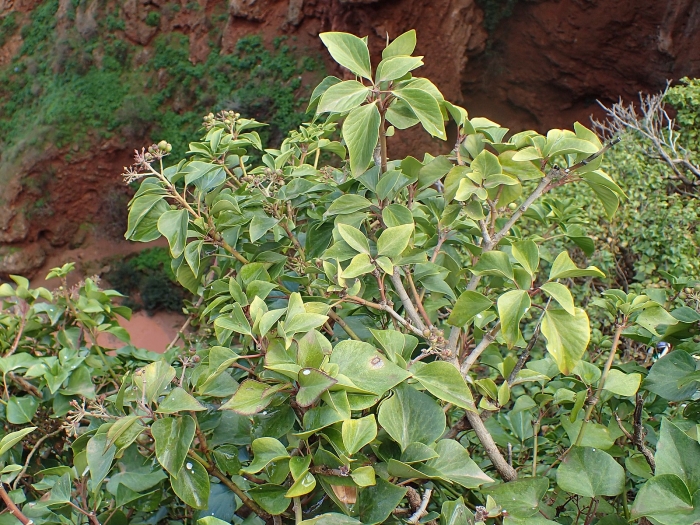Moroccan Ivy
(Hedera maroccana)
Moroccan Ivy (Hedera maroccana)
/
/

Krzysztof Ziarnek, Kenraiz
CC BY-SA 4.0
Image By:
Krzysztof Ziarnek, Kenraiz
Recorded By:
Copyright:
CC BY-SA 4.0
Copyright Notice:
Photo by: Krzysztof Ziarnek, Kenraiz | License Type: CC BY-SA 4.0 | License URL: https://creativecommons.org/licenses/by-sa/3.0 | Uploader: Kenraiz | Publisher: Wikimedia Commons |







Estimated Native Range
Summary
Hedera maroccana, commonly known as Moroccan Ivy, is an evergreen perennial vine originating from the forested regions and woodland margins of Northwest Africa. It can climb to heights of 20–30 meters when provided with suitable surfaces such as trees, cliffs, or walls, and it also serves as an effective ground cover in the absence of vertical supports. Moroccan Ivy adheres to surfaces using aerial rootlets that cling firmly to the substrate. Its growth habit is vigorous, especially in warm climates, where it outpaces relatives like Hedera hibernica and Hedera helix in terms of establishment and growth rate.
Moroccan Ivy is appreciated for its lush, dense foliage which provides year-round greenery. It is often used to cover unsightly walls, soften building lines, or provide ground cover in shaded areas. The plant’s small, greenish flowers are not particularly showy, but they do attract pollinators before giving way to globular, black berries when ripe. The stems of Hedera maroccana are green or greenish-brown, occasionally showing tinges of red or purple. In cultivation, it requires well-drained soil, tolerates a range of light conditions from full sun to deep shade, and needs regular watering until established. While it is relatively low-maintenance, it can be susceptible to leaf spot diseases and can suffer in extreme cold. Due to its vigorous growth, Moroccan Ivy can become invasive outside its native range, so it is crucial to check local regulations before planting.CC BY-SA 4.0
Moroccan Ivy is appreciated for its lush, dense foliage which provides year-round greenery. It is often used to cover unsightly walls, soften building lines, or provide ground cover in shaded areas. The plant’s small, greenish flowers are not particularly showy, but they do attract pollinators before giving way to globular, black berries when ripe. The stems of Hedera maroccana are green or greenish-brown, occasionally showing tinges of red or purple. In cultivation, it requires well-drained soil, tolerates a range of light conditions from full sun to deep shade, and needs regular watering until established. While it is relatively low-maintenance, it can be susceptible to leaf spot diseases and can suffer in extreme cold. Due to its vigorous growth, Moroccan Ivy can become invasive outside its native range, so it is crucial to check local regulations before planting.CC BY-SA 4.0
Plant Description
- Plant Type: Vine
- Height: 10-90 feet
- Width: 3-10 feet
- Growth Rate: Moderate
- Flower Color: N/A
- Flowering Season: Summer, Fall
- Leaf Retention: Evergreen
Growth Requirements
- Sun: Full Sun, Part Shade, Full Shade
- Water: Low, Medium
- Drainage: Medium, Fast
Common Uses
Bee Garden, Bird Garden, Butterfly Garden, Low Maintenance
Natural Habitat
Forested regions and woodland margins of Northwest Africa
Other Names
Common Names:
Scientific Names: , Hedera maroccana, Hedera helix subsp. maroccana,
GBIF Accepted Name: Hedera maroccana McAll.